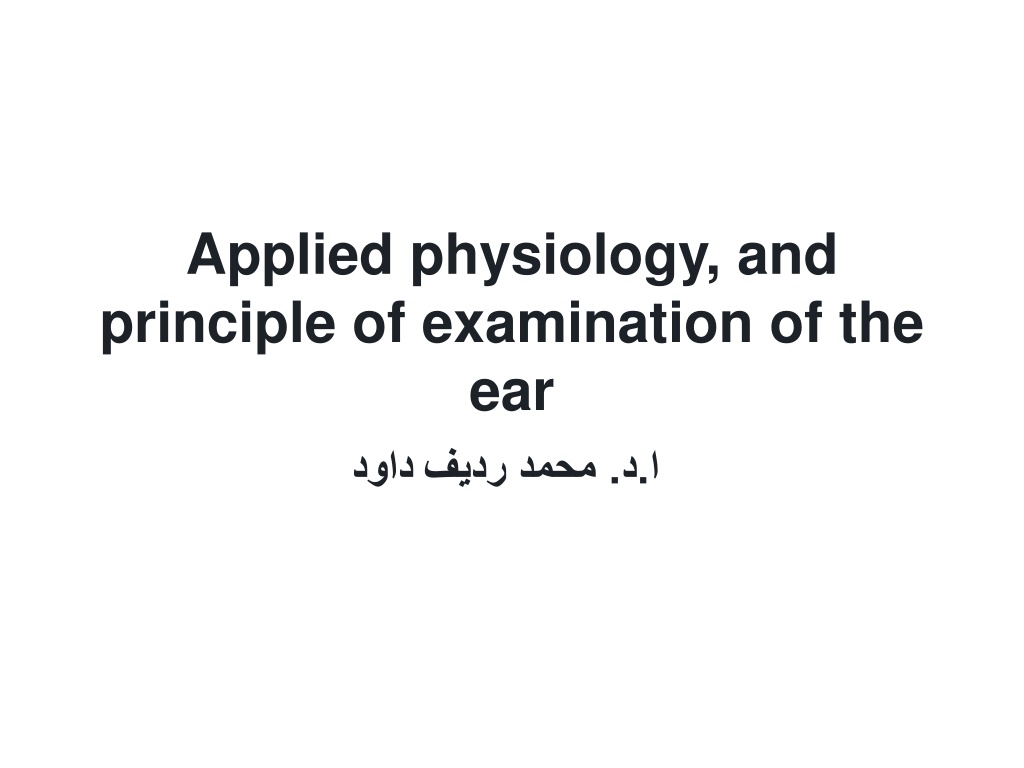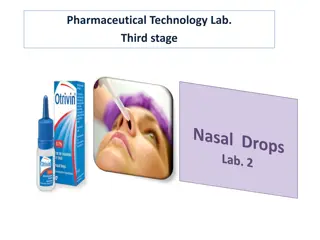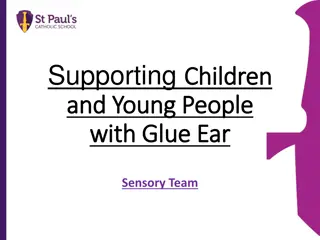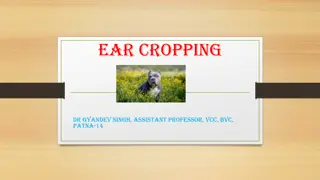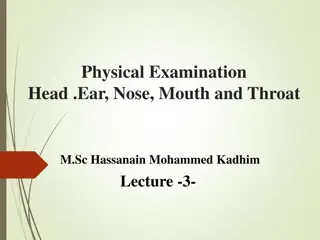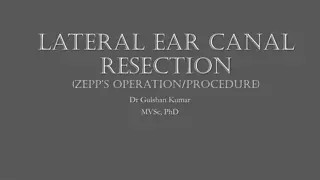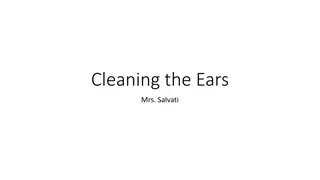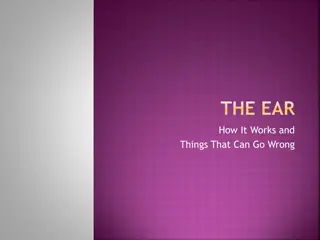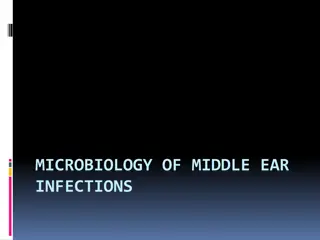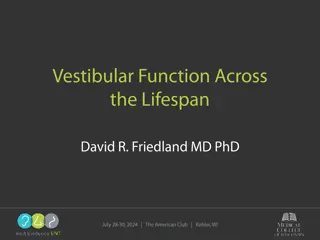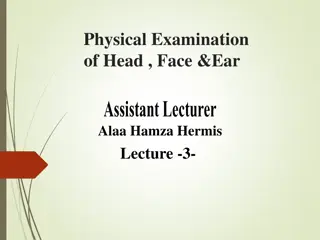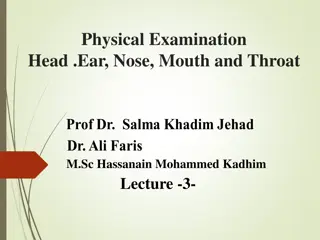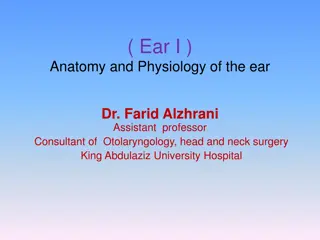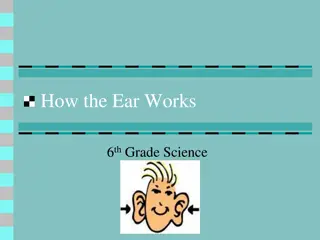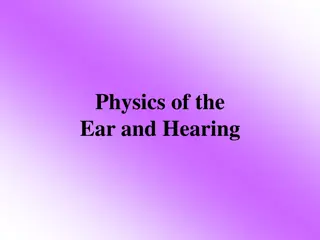Understanding Ear Physiology and Examination Principles
The ear plays a critical role in both hearing and balance. Understanding the physiology of hearing involves 6 basic steps, from sound transfer to neural impulse transmission. When assessing hearing, methods like whispering tests and tuning fork tests can help determine different types of deafness. Proper techniques and patient communication are key during these examinations.
Download Presentation

Please find below an Image/Link to download the presentation.
The content on the website is provided AS IS for your information and personal use only. It may not be sold, licensed, or shared on other websites without obtaining consent from the author. Download presentation by click this link. If you encounter any issues during the download, it is possible that the publisher has removed the file from their server.
E N D
Presentation Transcript
Applied physiology, and principle of examination of the ear . .
The functions of the ear: 1.Hearing 2.Balance
Physiology of hearing There are 6 basic steps of hearing: 1. Sound transfers into the ear canal to the tympanic membrane (TM) 2. The tympanic membrane will vibrate with vibrates with the different sounds 3. These sound vibrations make their way through the ossicles (in the middle ear) to the cochlea (Inner ear), by what's called lever mechanism of ossicles, and also by area difference of tympanic membrane and the oval window. 4. So it vibrates the perilymph in the cochlea (in the inner ear) and produce travelling waves along a specific points along the basilar membrane, so the high frequency of the sound at basal turn of cochlea and low frequencies at its apical part. 5. its lead to movement of the hair cells this will transform the physical properties to electrical neural impulse 6. The auditory nerve picks up any neural signals created by the hair cells to the brain auditory center via the cochlear division of 8thcranial nerve.
Hearing assessment 1. Wash your hands 2. Introduce yourself to the patient including your name and role. 3. Briefly explain what the examination will involve using patient-friendly language. 4. Ask the patient to sit on a chair. 5. Ask the patient if they have any pain before proceeding with the clinical examination.
First: Whispering test Position patient s ear and then whisper a number or word yourself approximately 60cm from the 2. Mask the ear not being tested by rubbing the tragus, it is far nicer to occlude the ear from behind the head.. 3. Ask the patient to repeat the number or word back to you. 4. Assess the other ear in the same way.
Second: Tuning fork tests 512Hz tuning fork is used as it gives the best balance between time of decay and tactile vibration. 1. Weber s test: A. Tap a 512Hz tuning fork and place in the midline of the forehead. B. Ask the patient Where do you hear the sound? Normal: sound is heard equally in both ears. Sensorineural deafness: sound is heard louder on the side of the intact ear. Conductive deafness: sound is heard louder on the side of the affected ear.
2. Rinnes test A. Place a vibrating 512 Hz tuning fork in front of the external auditory meatus to test air conduction B. Place a vibrating 512 Hz tuning fork on the mastoid bone to test bone conduction. If air conduction is better than bone conduction, which is what would be expected in a healthy individual or in sensorineural hearing loss it referred to as a (Rinne s positive). If bone conduction > air conduction (Rinne s negative) which seen in conductive deafness.
3. Absolute Bone Conduction (ABC) test Absolute Bone Conduction (ABC) test: To compare the bone conduction of the patient with that of the examiner (assuming he is normal).
Third: Audiometry 1. Subjective Audiometric Tests: such as pure tone audiometry (PTA), speech audiometry. In children: behavioral hearing tests, visual response audiometry, and play audiometry 2. Objective Audiometric Tests: such as: Impedance audiometry: tympanometry and acoustic reflex (AR), oto-acoustic emissions (OAEs), brainstem evoked response audiometry (BERA).
Clinical examination 1. Inspection Inspect the pinna for: Asymmetry: by comparing the pinnae you may identify subtle unilateral pathology. Deformity of the pinnae: this may be acquired (e.g. cauliflower ear) or congenital (e.g. anotia, microtia). Erythema and oedema: typically associated with otitis externa. Scars: indicative of previous surgery. Skin lesions: look for evidence of malignant (e.g. basal cell carcinoma).
Continue on inspection Inspect the mastoid region: Erythema and swelling: typically associated with mastoiditis, mastoid abscess. Inspect the post-auricular sulcus: As surgical incision or scars: indicative of previous surgery (e.g. mastoidectomy), etc. Inspect the pre-auricular region (in front of the ear): As pre-auricular sinus, swelling, lymphadenopathy, etc.
2. Palpation Palpate the tragus for tenderness which is typically associated with otitis externa ( furunculosis), palpate the regional lymph nodes:
3. Otoscopy 1. Check if the patient has any ear discomfort and if so examine the non-painful side first. 2. Apply a sterile speculum (the largest that will comfortably fit in the external auditory meatus). 3. Pull the pinna upwards and backwards in adults, while outwards and backwards in children with your other hand to straighten the external auditory canal 4. Advance the otoscope under direct vision. Be gentle with the otoscope and ensure movements are slow.
Continue on otoscopy 5 . External auditory canal assessment:: Ear wax, erythema and oedema, discharge (otorrhea), foreign bodies: 6. Tympanic membrane assessment: Colour, position, transparency, integrity (intact or perforated), presence or absence cone of light (light reflex), mobility by pneumatic otoscope. 7. Repeat your assessment on the other ear, comparing your findings. 8. Thank the patient for their time, and wash your hands.
4. Others examinations 1. Pneumatic otoscopy. 2. Post-nasal examination. 3. Facial nerve examination.
Balance mechanism The Balance of the body is maintained by co-ordination of information from 3 sensory systems: 1. The vestibular system 2. The eyes or Visual system 3. The proprioceptive system: sensation from muscles, joints, tendons and ligaments. The semicircular canals (SCCs): are stimulated by angular acceleration around an axis. The vestibule: is concerned with identification of head position in relation to gravitational field and linear acceleration and deceleration.
Clinical tests of balance 1.Romberg`s test The patient is asked to stand erect with the feet together and close his eyes, in labyrinthine lesion he will sway to the side of lesion. 2.Unterberg's test The patient is asked to stand erect with the feet together but with hand outstretched and March on spot with eyes closed, so labyrinthine lesion he will rotate toward the side of lesion. 3.Gait test The patient ask to walk on straight line between 2 points then ask quickly turn to return on the same line, patient with labyrinthine lesion will deviate to side of lesion.
